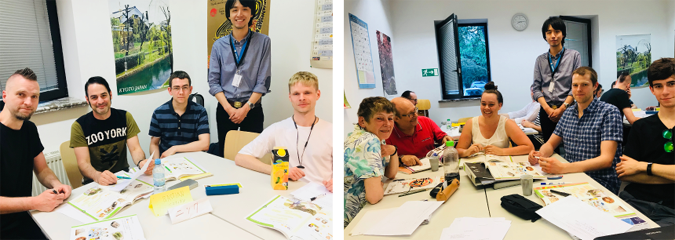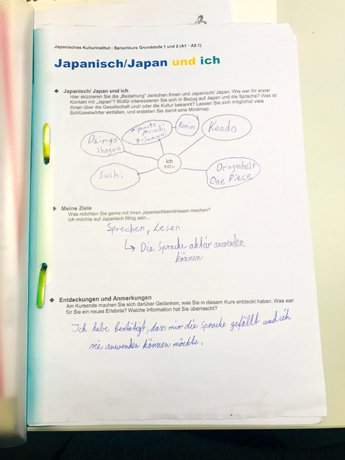Japanese-Language Courses and Cologne, a City of Diversity
The Japan Cultural Institute in Cologne
MATSUURA Tomoko, HIRAKAWA Shunsuke
If you were to join a class to study a certain language, what would you expect? This question likely evokes a variety of answers, such as gaining the ability to speak the language, learning about the culture behind it, or preparation to travel to the country where it is spoken.
A variety of people attend the Japanese-language course at The Japan Cultural Institute in Cologne (hereinafter “JKI”) and enjoy learning Japanese for a variety of reasons. In this article, I will focus on the learners at JKI to give a report on the possibilities for the Japanese-language course.

A Japanese-language course at The Japan Cultural Institute in Cologne
The City of Cologne
Cologne is a city in western Germany and home to JKI. Germans typically describe Cologne with words such as “open-mindedness” or “diverse.” It is also often described as the “southern Europe of Germany” or the “Latin part of Germany” because it is known for the bright and cheerful people who will often casually greet strangers and strike up conversations in the street. People from other cities in Germany are often surprised by the friendliness of the people of Cologne. This is in part because of the history of mixing with diverse peoples and cultures in the city, such as the confluence of people and goods through the city since Roman times, and the hosting of countless foreign workers during the city’s reconstruction after WWII. As a result, Cologne is now home to people of diverse backgrounds, perhaps embodying the diversity of Germany where it is said that one in five people have foreign roots. Perhaps because of this cultural climate and history, the people of Cologne seem to both enjoy and take pride in their diversity.
The JKI Japanese-Language Course where Diverse Students Learn Together in the Classroom

“Me and Japanese/Japanese Studies”
The variety of ways in which each student interacts with the Japanese language is deeply fascinating.
So, what sort of people attend the Japanese-language courses at JKI? The JKI Japanese-language course is a course for the general public that has been held since 1970, and anyone of 13 and above can attend. The students come from a wide range of age groups and occupations, with the largest number being college students and adults in their 20s and 30s, followed by junior high and high school students in their teens, but there is also good representation from those in their 40s and 50s and even retirees. The motivations they have for joining the course are also diverse, with each learning Japanese for their own reason, including for travel to Japan, an interest in Anime or Japanese martial arts, or because their child married a Japanese person and their grandchild lives in Japan. The students also have diverse roots and native languages. The pre-course questionnaire has a box for native language, and one can see from the responses that the diverse linguistic roots of the students include not only German but also Turkish, Italian, Spanish, Farsi, Vietnamese, and many others. As you can see, the JKI Japanese-language course stands out because a rich tapestry of peoples come to study together in a classroom due to a shared interest in Japanese, and perhaps this is also one of its appeals.
The JKI Japanese-language course uses teaching materials developed by the Japan Foundation called “Marugoto: Japanese Language and Culture”. The materials are based on a concept of building relationships by communicating your ideas and opinions with each other while acquiring the Japanese language, and even at the starter level (A1) when the student has just begun to learn Japanese, they gain the ability to speak about their hobbies or work in Japanese. Furthermore, the classroom format is based on a philosophy of mutual understanding, so another notable characteristic is that the classes proactively incorporate not only building Japanese language ability, but interaction with other cultures and exchanging opinions, such as by talking about one’s reactions to Japanese society and customs in the vernacular. One practical example of this is the teaching materials I created entitled “Me and Japanese/Japanese Studies.” The materials involve visualizing one’s relationship to the Japanese language using a diagram like a mind map, and sharing it with the class to promote communications and as an opportunity for students to learn about each other.
Benefits Gained from the Japanese-Language Course
What would the effect be if, as part of your weekly studies, you were able to meet and interact with the type of people you did not encounter in daily life, such as people of your parent’s age, people with different occupations, different roots, or who speak different native languages? And what would happen if there were an environment where you could exchange opinions and ideas with people who think differently than you?
Some, for example, might find it to be a place to expand their sense of values. And for others, it might be an opportunity to learn how to acknowledge the lifestyles and thinking processes of other people. Yet others might learn to tolerate the unknown.
In this way, when students of the JKI Japanese-language course spend time together with people who are different than them, working together and conversing with them, they not only improve their Japanese ability, but they enrich their lives as well. I cannot help but sense these possibilities when I see the students enjoying Japanese together at JKI.
The increasing mobility of modern society has led to a further mixing of different customs and values. I believe that the JKI Japanese-language course, at which gather the people of Cologne who see diversity as a positive thing by valuing that which is different, will continue to expand those possibilities moving forward.
(Author: HIRAKAWA Shunsuke)
- What We Do Top
- Arts and Cultural Exchange [Culture]
- Japanese-Language Education Overseas [Language]
- Japanese-Language Education Overseas [Language] Top
- Learn Japanese-language
- Teach Japanese-language
- Take Japanese-Language Test
- Know about Japanese-language education abroad
- The Japanese-Language Institute, Urawa
- The Japanese-Language Institute, Kansai
- Japanese-Language Programs for Foreign Specified Skilled Worker Candidates
- Japanese Language Education for Japanese Children Resident Overseas and for the Descendants of Migrants
- Archives
- Japanese Studies and Global Partnerships [Dialogue]
- JF digital collection
- Other Programs / Programs to Commemorate Exchange Year
- Awards and Prizes
- Publications
